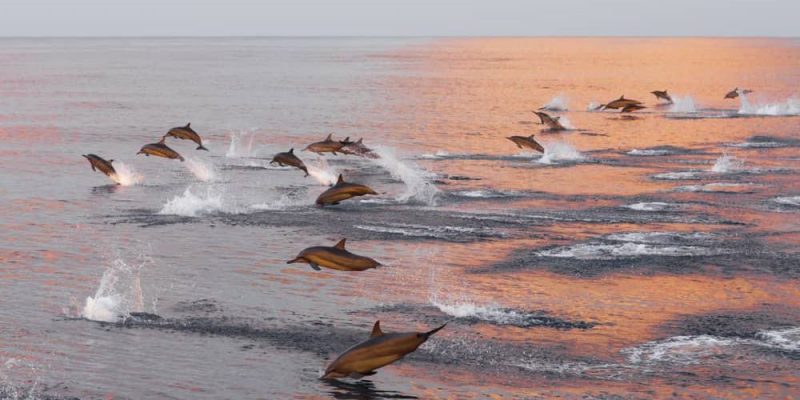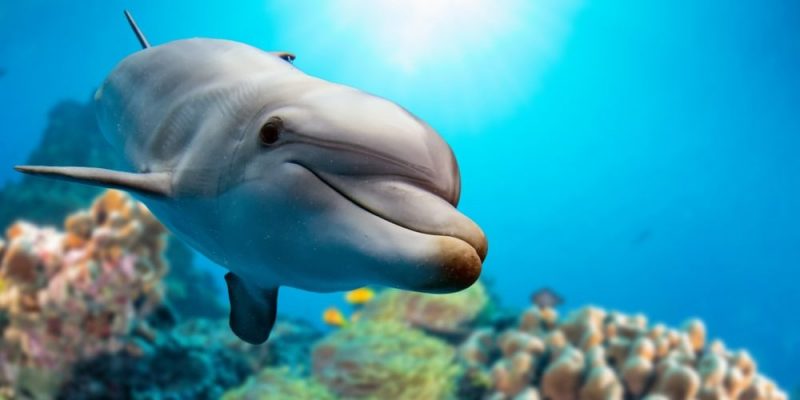We explain everything about dolphins, where they live, what they feed on and how they reproduce. Also, what types of dolphins exist.

What are dolphins?
The dolphins are cetacean mammals with aquatic life, inhabitants of seas and rivers Depending on the species, they are among the most intelligent animal species on the planet.
In general, when we think of dolphins we refer to the 37 species that make up the oceanic variant (of the family delphinidae), which inhabit the maritime surface and maintain frequent and friendly relations with humans, despite the fact that they are often accidental victims of their commercial and fishing activities.
Dolphins are, from a zoological point of view, little more than toothed whales, that is, marine mammals that returned from land to marine life, sometime in the Miocene 23 million years ago, when they presented the necessary evolutionary adaptations for this. It is thought that the common ancestor between dolphins and land animals was a species of artiodactyls, that is, prehistoric hippos.
In most cultures dolphins are considered friendly and intelligent. In fact, are sociable animals, perfectly trainable which today are a regular part of shows and water parks.
Their presence in ancient mythological stories is common in maritime cultures, such as the Greeks, in which they were said to have been pirates, transformed into fish by the god Dionysus after they tried to sell him as a slave. In his representations of Poseidon, god of the seas, he often appears surrounded by seahorses and dolphins.
See also: Sea animals
Dolphin Characteristics

Broadly speaking, dolphins are characterized by the following:
- They are aquatic mammals, that is, they have a body adapted to water (with fins instead of legs), but at the same time they breathe the air and have warm blood. They are not fish.
- have a torpedo-shaped body ideal for swimming at high speeds, which begins with a thin and toothed snout, and culminates with a powerful tail that has a caudal fin, with which it propels itself.
- His skin is gray-blue darker on the back and lighter on the belly, free of any form of fur. Different species may have characteristic colored spots and lines.
- have a large brain with a highly developed cerebral cortex, compared to the average mammal, which allows them complex social interaction: playing, communicating, teaching their young, cooperating, planning and suffering.
- Sincee are capable of establishing strong social bonds they can be found in large groups of up to 1000 individuals, in which the sick are cared for and attended to.
- manage a complex echolocation system emitting sounds in a burst to perceive the echoes that return, like a radar. In this way they can perceive potential prey and monitor the environment around them. To do this, they have an organ called “melon” in their heads.
- The dolphins are capable of vocalizing a very wide range of sounds such as hisses and clicks.
Where do dolphins live?

Dolphins commonly inhabit the surface regions of seas, rivers and lakes depending on the family and species. They spend their entire life in the water, without having to venture onto dry land, and always prefer the warm waters of the tropics and surrounding regions.
What do dolphins eat?

The dolphins are carnivores, and their diet consists of small fish and squid. They are intelligent hunters, who have very varied strategies to isolate their prey from the school or to ambush them.
How do dolphins reproduce?
As with mammals in general, Dolphin reproduction is sexual and viviparous, with internal fertilization of the female by the male.
Coitus occurs from the front, lasts a short time and is repeated several times, after a courtship in which the male reproduces striking sounds for the female, swimming around her. Dolphin gestation lasts about a year although in some species it can last a year and a half, and in the end there is only one calf per birth.
How long do dolphins live?
The life expectancy of dolphins can be around 20 and 30 years and spread further in ideal conditions of captivity. In the wild, this species does not have large predators or threats.
However, yes are threatened by humans due to environmental contamination by pesticides, heavy metals and plastics, or accidental fishing in the middle of schools of commercial fish (such as tuna). There are also some countries in which dolphin is part of traditional cuisine, such as Japan and the Faroe Islands.
Types of dolphins

There are two “types” of dolphins, with different habitats and different characteristics, since they are two different superfamilies, each covering a different set of species:
- oceanic dolphins or dolphins typical sea dolphins, coastal inhabitants that interact a lot with humans, like the common dolphin in the movies.
- River dolphins or platanistoideans inhabitants of estuaries and rivers, with a long trunk (almost 60 cm) and smaller body size, such as the dolphin or Amazon dolphin.
Continue with: Animals of the coast
References
- “Delphinidae” on Wikipedia.
- “Dolphins” in National Geographic.
- “The Dolphin” (video) in Happy Learning Spanish.
- “Curiosities about dolphins” in VERY Interesting.
- “Dolphin (mammal)” in The Encyclopaedia Britannica.





